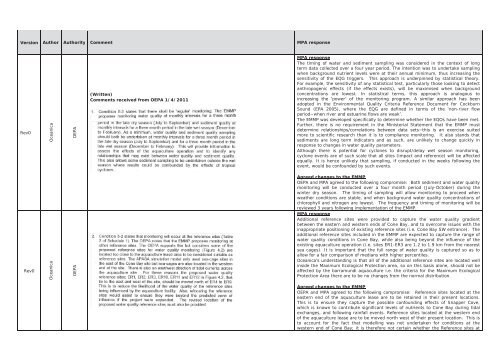Marine Produce Australia: Cone Bay Barramundi Aquaculture ...
Marine Produce Australia: Cone Bay Barramundi Aquaculture ...
Marine Produce Australia: Cone Bay Barramundi Aquaculture ...
Create successful ePaper yourself
Turn your PDF publications into a flip-book with our unique Google optimized e-Paper software.
Version Author Authority Comment MPA response<br />
Rev0<br />
Rev0<br />
Oceanica<br />
Oceanica<br />
OEPA<br />
OEPA<br />
(Written)<br />
Comments received from OEPA 1/4/2011<br />
MPA response<br />
The timing of water and sediment sampling was considered in the context of long<br />
term data collected over a four year period. The intention was to undertake sampling<br />
when background nutrient levels were at their annual minimum, thus increasing the<br />
sensitivity of the EQG triggers. This approach is underpinned by statistical theory.<br />
For example, the sensitivity of any statistical test, particularly those looking to detect<br />
anthropogenic effects (if the effects exists), will be maximised when background<br />
concentrations are lowest. In statistical terms, this approach is analogous to<br />
increasing the ‘power’ of the monitoring program. A similar approach has been<br />
adopted in the Environmental Quality Criteria Reference Document for Cockburn<br />
Sound (EPA 2005), where the EQG are defined in terms of the ‘non-river flow<br />
period−when river and estuarine flows are weak’.<br />
The EMMP was developed specifically to determine whether the EQOs have been met.<br />
Further, there is no requirement in the Ministerial Statement that the EMMP must<br />
determine relationships/correlations between data sets−this is an exercise suited<br />
more to scientific research than it is to compliance monitoring. It also stands that<br />
sediments are long term indicators and as such, are unlikely to change quickly in<br />
response to changes in water quality parameters.<br />
Although there is potential for cyclones to disrupt/delay wet season monitoring,<br />
cyclone events are of such scale that all sites (impact and reference) will be affected<br />
equally. It is hence unlikely that sampling, if conducted in the weeks following the<br />
event, would be confounded by such events.<br />
Agreed changes to the EMMP<br />
OEPA and MPA agreed to the following compromise: Both sediment and water quality<br />
monitoring will be conducted over a four month period (July-October) during the<br />
winter dry season. The timing of sampling will allow monitoring to proceed when<br />
weather conditions are stable, and when background water quality concentrations of<br />
chlorophyll and nitrogen are lowest. The frequency and timing of monitoring will be<br />
reviewed 3 years following implementation of the EMMP.<br />
MPA response<br />
Additional reference sites were provided to capture the water quality gradient<br />
between the eastern and western ends of <strong>Cone</strong> <strong>Bay</strong>, and to overcome issues with the<br />
inappropriate positioning of existing reference sites (i.e. <strong>Cone</strong> <strong>Bay</strong> SW entrance). The<br />
additional reference sites included in the EMMP are expected to capture the range of<br />
water quality conditions in <strong>Cone</strong> <strong>Bay</strong>, while also being beyond the influence of the<br />
existing aquaculture operation (i.e. sites ER1-ER3 are 1.2 to 1.9 km from the nearest<br />
sea cages). It is important that the full range of water quality is captured so as to<br />
allow for a fair comparison of medians with higher percentiles.<br />
Oceanica’s understanding is that all of the additional reference sites are located well<br />
inside the Maximum Ecological Protection area, so on this basis alone, should not be<br />
affected by the barramundi aquaculture i.e. the criteria for the Maximum Ecological<br />
Protection Area there are to be no changes from the normal distribution.<br />
Agreed changes to the EMMP<br />
OEPA and MPA agreed to the following compromise: Reference sites located at the<br />
eastern end of the aquaculture lease are to be retained in their present locations.<br />
This is to ensure they capture the possible confounding effects of Snapper Cove,<br />
which is known to contribute significant levels of nutrients to <strong>Cone</strong> <strong>Bay</strong> during tidal<br />
exchanges, and following rainfall events. Reference sites located at the western end<br />
of the aquaculture lease are to be moved north west of their present location. This is<br />
to account for the fact that modelling was not undertaken for conditions at the<br />
western end of <strong>Cone</strong> <strong>Bay</strong>; it is therefore not certain whether the Reference sites at


